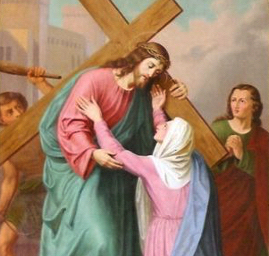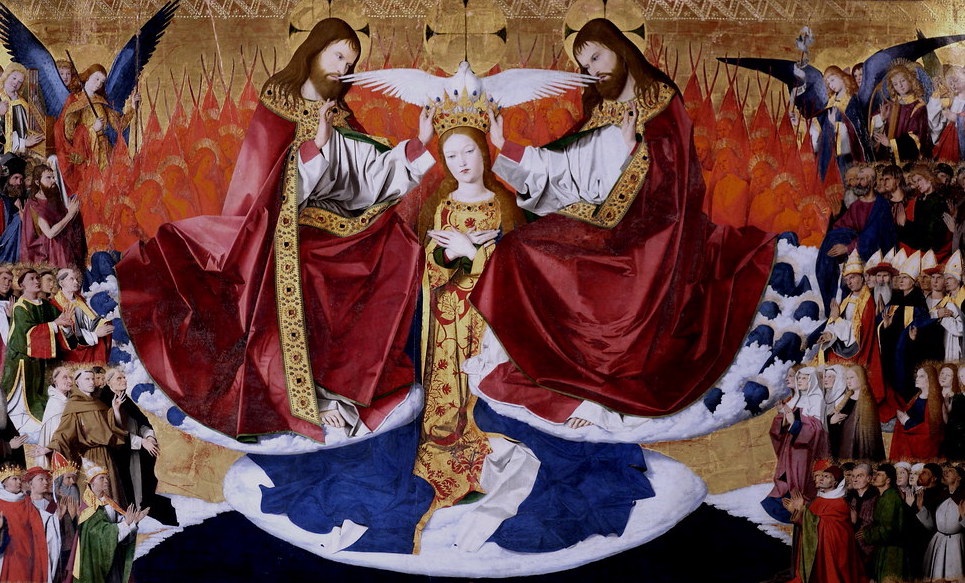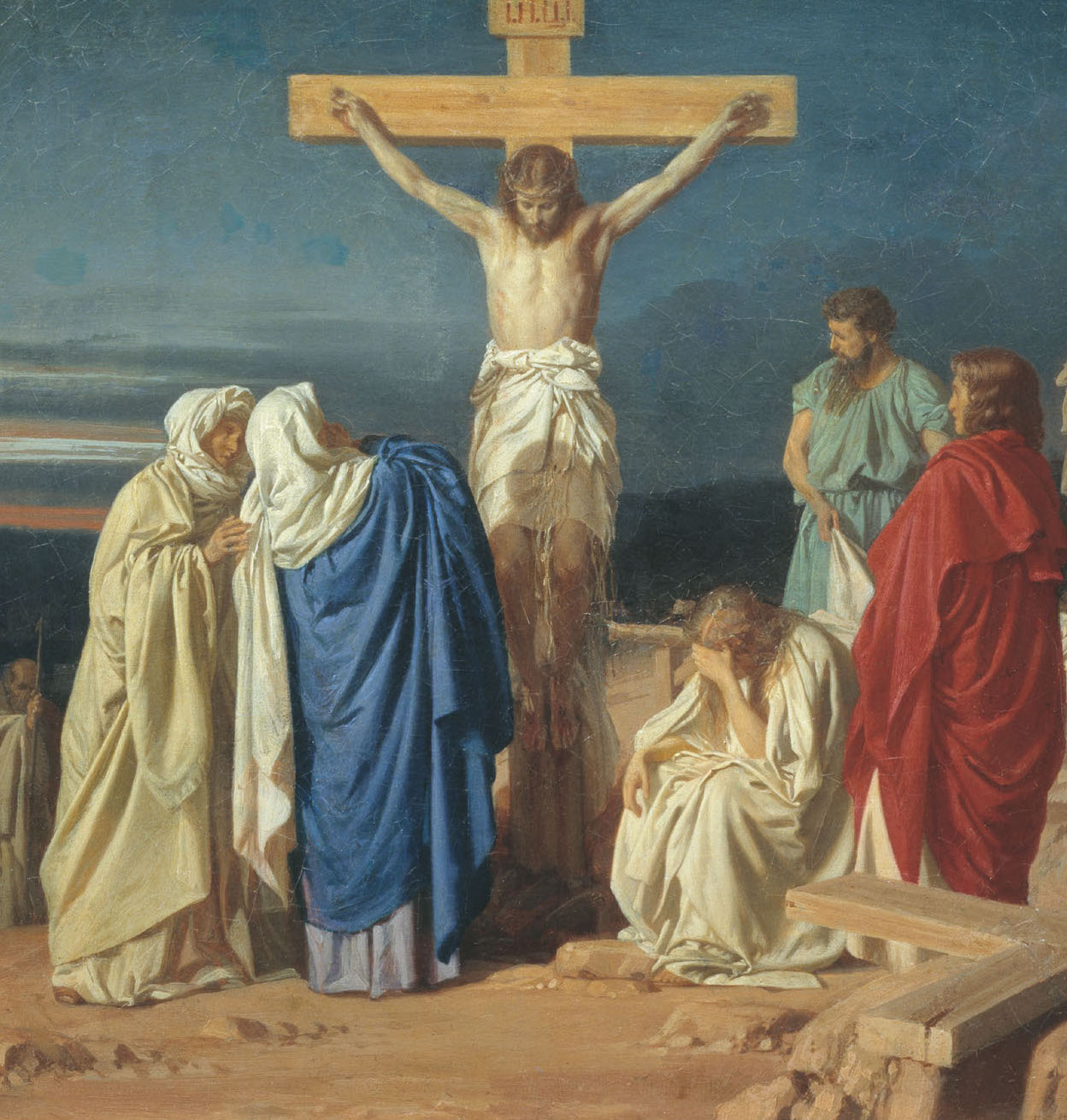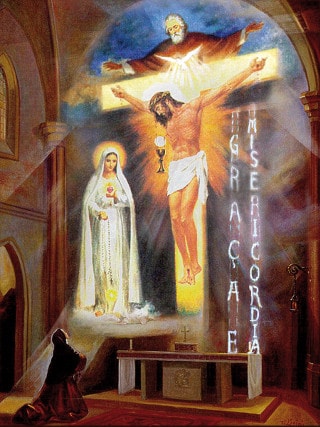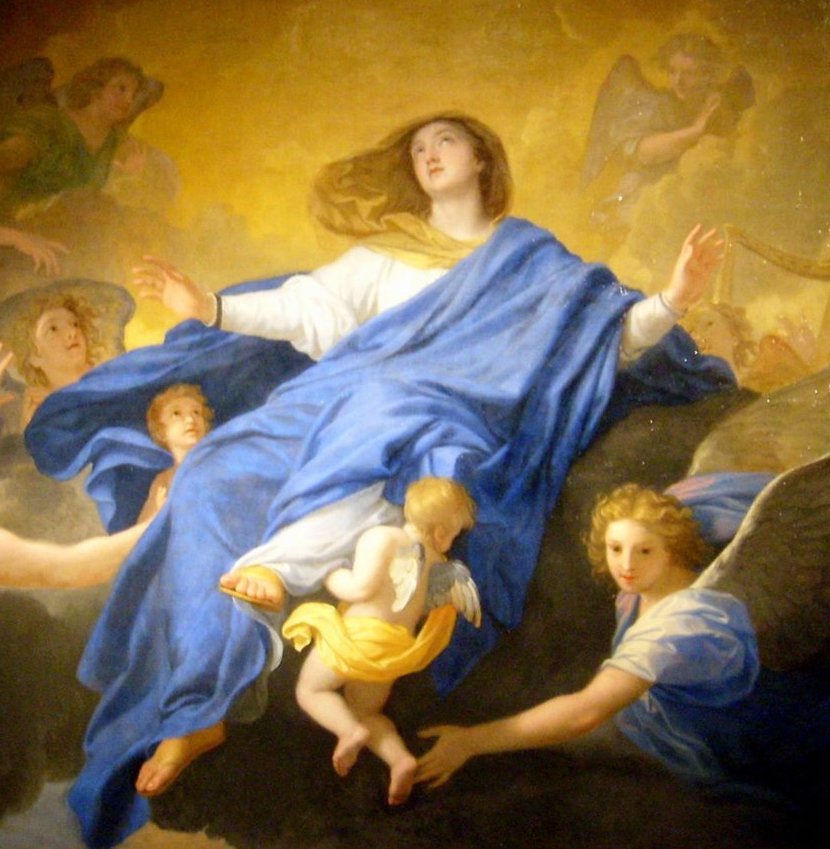Tomorrow we enter Passion Week. So, on this1st Saturday in April 2025, we’ll be meditating on the carrying of the cross. This painful mystery is very dense, and we’re going to start by focusing on an important passage: Jesus’ encounter with his Mother. After Jesus’ condemnation, the Blessed Virgin, accompanied by St. John and the holy women, made her way through the crowd to stand at the foot of a house where the procession was to pass. But before Jesus reached them, human wickedness was unleashed against Mary.
“The Mother of God was pale, her eyes red with tears, trembling and barely supporting herself. When the people carrying the instruments of torture approached with an insolent and triumphant air, the Mother of Jesus began to tremble and groan; she clasped her hands together, and one of these wretches asked: ” Who is this woman lamenting? “ Another replies , ” She is the Mother of the Galilean.” When these scoundrels heard these words, they mocked this sorrowful Mother; they pointed at her, and one of them took in his hand the nails that were to bind Jesus to the cross, and mockingly presented them to the Blessed Virgin”. (Visions of Blessed Anne Catherine Emmerich -ACE-)

What a despicable attitude towards Her who is nothing but charity and love! It was the first serious direct offence to the Blessed Virgin on the part of men. If we had been on the road to Calvary next to Mary, how would we have reacted? Would we have remained indifferent? Of course not. On the contrary, we would have done everything we could to protect her and make up for the insults of the crowd and the soldiers. Well, today the situation is the same. The modern world’s insults and blasphemies towards Our Lady continue, and are even worse than when the cross was carried. To make amends, Mary has asked us to make this little effort on the 1st Saturday of the month. Let’s be clear. If we don’t make these 1st Saturdays, it’s exactly as if we were on the road to Calvary beside Her, refusing to support and console Her for the ignominy She receives…
After the outrages of the executioners, the Blessed Virgin suddenly sees her son at last: “She looked at Jesus, clasping her hands together, and, broken by pain, leaned against the door, pale as a corpse and blue-lipped, so as not to fall”. (ACE) Having contemplated the radiant, good face of Our Lord for thirty-three years, she now sees it disfigured, crushed by suffering. At this sight, the sword prophesied by Saint Simeon at the Presentation in the Temple has just been thrust into her Mother’s Heart. It was then that Jesus, in turn, looked up and saw her:“His dull and bloody eyes, under the horrible braid of the crown of thorns, cast a sad and compassionate gaze on his sorrowful mother, and stumbling under his burden, he fell for the second time on his knees and on his hands” (ACE) Yes, the vision of his Mother’s pain is such an unbearable ordeal for Jesus that his strength abandons him.
That first glance between Jesus and Mary must have been unspeakably intense. Blessed Anne-Catherine Emmerich describes the scene from Mary’s side: “Mary, under the violence of her grief, saw neither soldiers nor executioners: she saw only her beloved Son reduced to this miserable state; she rushed from the door of the house into the midst of the archers who were ill-treating Jesus, fell on her knees beside him and embraced him” (ACE) Like Jesus, she fell on the road to Calvary, at his side. Here they are, both crushed to the ground by human wickedness. Their two hearts become one in this sacrifice made out of love for us, for our salvation.
Abbé Perroy, in his book “La montée au Calvaire”, describes the scene from Jesus’ side. “He lifted his blood-drenched head a little and looked at her [sa Mère]. What a look! What silence! There are sufferings that cannot be expressed; words would distort them; everything is said with a look and in silence. From that moment when Jesus met his Mother, there was a profound tearing in his Heart. (…) The sight of the dearest being par excellence was the most penetrating instrument of torment in the Passion: only those who have experienced́ the bite of similar pain will understand.”
While the memory of His agony in the Garden of Olives is still present, He now sees the agony of His own Mother begin. He knows that He has dragged her into this madness of redeeming the world. He could have spared her this if his legions of angels had intervened. But the Father’s will is different. He knows that by accepting his own sacrifice, he has brought about his Mother’s sacrifice. What a burden for Jesus. Having borne the sins of the world, He must now bear in His Heart the immense sorrow of His Blessed Mother. But as in the Garden of Olives, this new burden is still experienced in total submission to His Father’s will. And knowing His Mother, He knows that this submission is shared by Her in a perfect union of Heart with Him. This terrible trial unites them more than ever. A few seconds pass and Mary, pushed aside by the soldiers, disappears from his sight. Then Jesus patiently rises to his feet.
Let’s continue the Way of the Cross with Jesus. Did we notice that He spoke only once? He didn’t speak to the Blessed Virgin, nor to St. Veronica, nor to Simon of Cyrene. Surprisingly, His only words are to the daughters of Jerusalem, who are weeping because their sensibilities have been shaken by the violence of the spectacle. Then, faced with this, Jesus“turns” to them and says these grave words: “Do not weep for me, but for yourselves and for your children. (Lk 23.28). We can meditate on this passage by considering that Jesus is actually speaking to us.
Let’s take the scene again. With blood on his face, Jesus turns to me, who is meditating on the carrying of the cross, and says: “My friend, don’t feel sorry for me, but for your sinful soul, which is the cause of my suffering. Yes, the legitimate compassion we feel for Jesus as he walks to Calvary must not be limited to simple, sensitive sadness. It must be accompanied by the acute awareness that we are the cause. Saint Alphonsus de Liguori reminds us: “We must also observe that whatever Our Lord suffered in his passion, he suffered for each one of us in particular. for each one of us in particular . ” To live this Way of the Cross is both to contemplate the sorrows of our good and gentle Jesus and, at the same time, to throw ourselves to the ground beside Him, imploring His forgiveness. Our sadness for Jesus carrying His Cross is meaningless if, at the same time, we continue to lean on His Cross ourselves through our indifference to our faults, and it would be like the lamentations of the daughters of Jerusalem: a facade, not a true Love of Jesus.
To love Christ bearing his Cross is therefore a mixture of sensitive sorrow at his sufferings and deep remorse at being the cause of them; it’s to admire this gift, this self-denial of Jesus, who gives everything to save me and make amends for my faults. ” Lord! you loved me, not as yourself, but more than yourself; since, in order to deliver me from death, you wanted to die for me!” said Saint Alphonsus de Liguori. The same is true of the sword that sinks into the Heart of the Blessed Virgin Mary when she discovers her Son burdened with his Cross. This sword is thrust not by others, but above all by each and every one of us. Oh, how frightened we should be when we see what we have done to Jesus and Mary! But let’s not remain paralyzed by this reality, and let’s quickly transform this dread into true repentance. Then, instead of the despair caused by our responsibility, we’ll be enlightened by the Mercy of the Hearts of Jesus and Mary granted to those who know how to ask forgiveness.
Finally, Jesus’ words to the daughters of Jerusalem should also make us reflect on our attitude to the collapse of today’s world. We like to moan about the war that threatens and the evil that is on the rise everywhere. But we should also ask ourselves about our own mediocrity, which is also one of the causes of all this evil. Indeed, if our good deeds, thanks to the communion of saints, reflect well on all men without our noticing it, the same goes for our lukewarmness and our negligence, which contribute to the development of evil on earth, including in the Church. Before we weep for the world, let us first weep for ourselves, as Christ would tell us today.
Our Lady at Fatima told us exactly what she wanted to save the world: the rosary and the 1sters Saturdays of the month. But for the past 100 years, we’ve done little or nothing of the kind, and are therefore partly responsible for the world’s dramatic situation. In 2025, a pivotal year, it is therefore urgent to begin to carry out the 1st Saturdays of the month with confidence, because, as Saint Jacinta of Fatima said: “It is never too late to have recourse to the Hearts of Jesus and Mary”.
Author : Alliance 1ers Saturdays of Fatima
